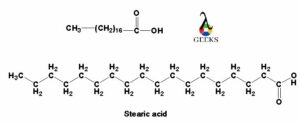Steraic acid has various names like Octadecanoic acid, Stearophanic acid, n-Octadecanoic acid, etc.
Stearic acid comes under the category of long chain saturated fatty acid which consists of eighteen carbon atoms. The fat of various plants and animals contains stearic acid. Stearic acid is a useful kind of saturated fatty acid comes from plants and animals and it is waxy solid.
Stearic Acid Structure
Chevreul M.E. was the scientist who basically discovers formula of stearic acid. Stearic acid named from the Gracian word “stear’ that means fat (specially known for beef fat). The stearic acid has molecular formula C18H36O2. Following is the stearic acid structure which consists of a long chain of carbon atoms containing total eighteen carbon atoms.
From all the carbon atoms sixteen carbons form a long chain of CH2 groups attached in the middle of the structure. At the one end of the structure with one methyl (CH3) group is attached and on the other end carboxylic (COOH) group is attached to it.

The IUPAC name of stearic acid is octadecanoic acid. The chemical formula for stearic acid is CH3(CH2)16COOH. It is a sticky in nature and white or slight yellowish solid crystalline powder with a characteristic mild odour. Stearic acid boiling point is 383 degree Celsius and melting point is 68.8 degree Celsius.
Stearic acid is the main constituent of shea butter and cocoa butter. Stearic acid has a mild odour and solid in nature which is whitish in colour. Stearic acid gets floats on water if we try to dissolve it in water.
Stearic acid is not soluble in water as we see it floating on water. But it is quietly slight soluble in some organic solvents like benzene and ethanol. Stearic acid is completely soluble in organic solvents like chloroform, acetone and carbon disulphide. Stearic acid can consider stable under some recommended storing conditions.
Stearic acid when heated to high temperature to decomposition it gets decomposed on boiling point of 360 degree Celsius and it also emits some irritating fumes and acrid smoke. Stearic acid gets volatize slowly at the temperature of 90 to 100 degree Celsius. Esterification of stearic acid is known as stearates.
Sodium or potassium salts of saturated fatty acids are known as soaps which are prepared by saponification or alkaline hydrolysis of fats. Stearic acid in pure form is obtained by various complicated methods like vacuum distillation, from a crystallization mixture, or acids chromatography and other suitable derivatives. Carboxylic acids are a typical chemical reaction undergone by pure acids, which is a waxy solid, colourless and not soluble in water.
Stearic acid comes under saturated fats which is active in various diets as contrast with the other saturated fats and carbohydrates. Stearic acid is better known for the decrease of nasty cholesterol i.e. low density lipoproteins (LDL) cholesterol. In various studies, stearic acid is shown to be quite safe.
Principal source of stearic acid is animal fats, with some contribution of green fats i.e. vegetable or botanical or plants fats except palm kernel oil, coconut, shea butter etc. Likewise, there is no proof that ingesting Stearic Acid causes heart disease and does not affect a blood lipid profile of any person during consumption.
Stearic acid has a very high melting point as it comes under saturated fatty acids. Stearic acid occurs in nature in dilute levels still it gets utilised in various food items. If stearic acid treated with magnesium metal, there is the formation of an ester magnesium stearate. Magnesium stearate is toxic in nature and should cause various negative effects after getting ingest. This magnesium stearate molecule is also causing irritation to the respiratory organs and skin on combustion and heats up freely.
Stearic Acid production
Stearic acid is made by oils and shows the properties of fatty acids. Stearic acid is produced by triglycerides saponification by heating the solution at the temperature of 100 degree Celsius. Then the subsequent solution gets distilled. Octadecanoic acid which is generally available is a mix acid i.e. the mixture of stearic acid and palmitic acid.
In terms of oils and fats, stereophonic acid consists of more fat of animals than vegetable fats. Cocoa butter and Shea butter is the only outliers which contains at least 28 to 45 per cent of stearic acids which possess the fatty acids properties. With the help of fatty acid machinery stearic acid can be made from crabs biosynthetically.
Uses of stearic acid
Stearic acid used as a flavouring agents in the food category like frozen dairy, baked goods, gelatin and puddings, non-alcoholic beverages, cheese, soft candies, hard candies, etc.
Stearic acid is used for ointments, suppositories, coating bitter remedies and coating enteric pills.
Stearic acid is used in the manufacturing of esters i.e. stearates with metals like zinc, aluminium and other metals.
Stearin soap is used for phonograph records, insulators, opodeldoc, candels, plaster of paris impregnation, compounds modelling, and vanishing cream and in some various other cosmetics.
Stearic acid is used as food additive and lubricating agent.
It is used in detergent production and pharmaceuticals manufacturing.
Stearic acid is used in food packaging industry and also in preparation of shampoos, soaps and cosmetics.

Hello everyone, I am Dr. Shruti M Ramteke, I did my Ph.D. in chemistry. I am passionate about writing and like to share my knowledge with others . Feel free to contact me on linkedin